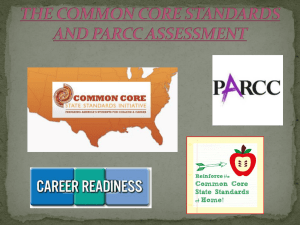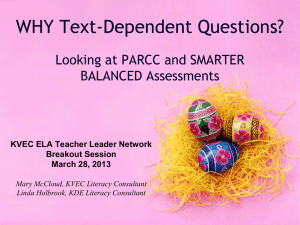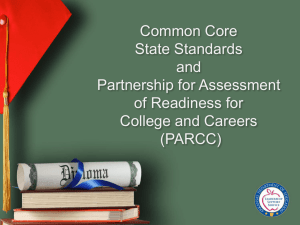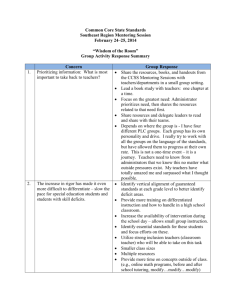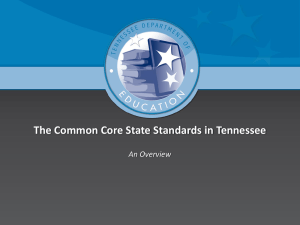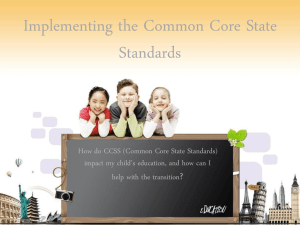September Presentation - Orange Public Schools
advertisement
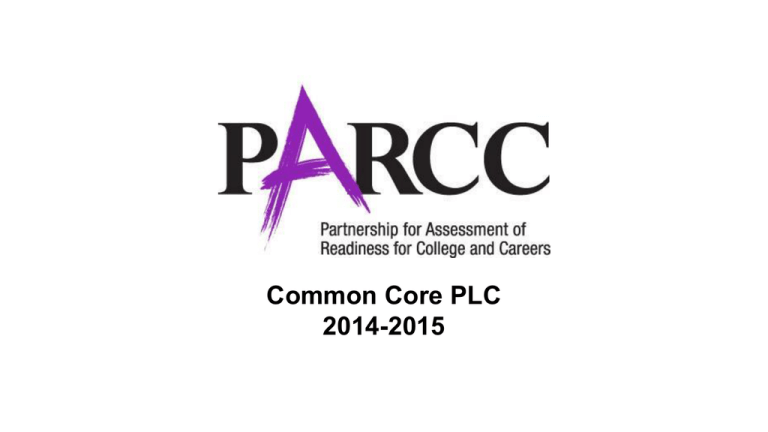
Common Core PLC 2014-2015 What is PARCC? ● The Partnership for Assessment of Readiness for College and Careers (PARCC) is a group of 19 states working together to develop a common set of computer-based K–12 assessments in English language arts/literacy and math linked to the new, more rigorous Common Core State Standards (CCSS). ● PARCC is one of two state consortia developing assessments aligned to the CCSS through the federal Race to the Top grant program. Overview of Assessment Design ● PARCC assessments in English language arts/literacy and mathematics will be administered in grades 3-11 beginning this year (2014-2015). ● Tests in each grade level will be based on the Common Core State Standards (CCSS) for that grade level. ● In high school, the PARCC test will be based on the CCSS designated for end-of-course exams for Algebra I, Algebra II, Geometry, English I, II, and III. The PARCC Goals 1. Create high-quality assessments 2. Build a pathway to college and career readiness for all students 3. Support educators in the classroom. 4. Develop 21st century, technology-based assessments 5. Advance accountability at all levels 6. Build an assessment that is sustainable and affordable. Create High Quality Assessments Priority Purposes of PARCC Assessments: 1.Assess the full range of the Common Core Standards, including standards that are difficult to measure. 2.Measure the full range of student performance, including high and low performing students. 3.Provide data during the academic year* to inform instruction, interventions, and professional development. 4.Provide data for accountability, including measures of growth. 5.Incorporate innovative approaches throughout the system. Create High Quality Assessments continued... Two summative, required assessment components 1. A performance- based assessment (PBA) 2. An end-of-year assessment (EOY) Designed to: ● Make “college- and career-readiness” and “on-track” determinations ● Measure the full range of standards and full performance continuum ● Provide data for accountability uses, including measures of growth PARCC Timeline Time Allocation Time Allocation Part 2 Time Allocation Part 3 Evidence Tables & Clarifications What are they? Math Clarifications Table Reading Evidence Table Writing Evidence Table (what do you notice?) www.parcconline.org Scaffolded Evidence for Mastery on the PARCC Purpose of Evidence and Clarification Tables ★ Drive Instruction ★ Plan Lessons ★ Develop Assessments ★ What can we do in our instruction to help students master the skills? Showing Evidence Standard: RI 5.2: Determine two or more main ideas of a text and explain how they are supported by key details; summarize the text. Evidences ● Provides a statement of two or more main ideas of a text. (1) ● Provides an explanation of how two or more main ideas are supported by key details. (2) ● Provides a summary of the text.. (3) Progression Charts: What are they? These charts: ★ Trace the changes to the standard between previous and current grade levels. ★ Highlight the shifts in a single standard. Progressions of the CCSS: Writing Grade 1, Standard 1 (W.1.1) Grade 2, Standard 1 (W.2.1) Grade 3, Standard 1 (W.3.1) Write opinion pieces in which they introduce the topic or name the book they are writing about, state an opinion, supply a reason for the opinion, and provide some sense of closure. Write opinion pieces in which they introduce the topic or book they are writing about, state an opinion, supply reasons that support the opinion, use linking words (e.g., because, and, also) to connect opinion and reasons, and provide a concluding statement or section. Write opinion pieces on topics or texts, supporting a point of view with reasons. A. Introduce the topic or text they are writing about, state an opinion, and create an organizational structure that lists reasons. B. Provide reasons that support the opinion. C. Use linking words and phrases (e.g., because, therefore, since, for example) to connect opinion and reasons. D. Provide a concluding statement or section. Progressions of the CCSS Writing, cont. Grade 7, Standard 1 (W.7.1) Grade 8, Standard 1 (W.8.1) Grade 9-10, Standard 1 (W.9-10.1) Write arguments to support claims with clear reasons and relevant evidence. A. Introduce claim(s), acknowledge alternate or opposing claims, and organize the reasons and evidence logically. B. Support claim(s) with logical reasoning and relevant evidence, using accurate, credible sources and demonstrating an understanding of the topic or text. C. Use words, phrases, and clauses to create cohesion and clarify the relationships among claim(s), reasons, and evidence. D. Establish and maintain a formal style. E. Provide a concluding statement or section that follows from and supports the argument presented. Write arguments to support claims with clear reasons and relevant evidence. A. Introduce claim(s), acknowledge and distinguish the claim(s) from alternate or opposing claims, and organize the reasons and evidence logically. B. Support claim(s) with logical reasoning and relevant evidence, using accurate, credible sources and demonstrating an understanding of the topic or text. C. Use words, phrases, and clauses to create cohesion and clarify the relationships among claim(s), counterclaims, reasons, and evidence. D. Establish and maintain a formal style. E. Provide a concluding statement or section that follows from and supports the argument presented. Write arguments to support claims in an analysis of substantive topics of texts, using valid reasoning and relevant and sufficient evidence. A. Introduce precise claim(s), distinguish the claim(s) from alternate or opposing claims, and create an organization that establishes clear relationships among claim(s), counterclaims, reasons, and evidence. B. Develop claim(s) and counterclaims fairly, supplying evidence for each while pointing out the strengths and limitations of both in a manner that anticipates the audience’s knowledge level and concerns. C. Use words, phrases, and clauses to link the major sections of the text, create cohesion, and clarify the relationships between claim(s) and reasons, between reasons and evidence, and between claim(s) and counterclaims. D. Establish and maintain a formal style and objective tone while attending to the norms and conventions of the discipline in which they are writing. E. Provide a concluding statement or section that follows from and supports the argument presented. Progressions of the CCSS: Math 3.G.1 Geometry Reason with shapes and their attributes. 1.Understand that shapes in different categories (e.g., rhombuses, rectangles, and others) may share attributes (e.g., having four sides), and that the shared attributes can define a larger category (e.g., quadrilaterals). Recognize rhombuses, rectangles, and squares as examples of quadrilaterals, and draw examples of quadrilaterals that do not belong to any of these subcategories. 4.G.2 Geometry Draw and identify lines and angles, and classify shapes by properties of their lines and angles. 2. Classify two-dimensional figures based on the presence or absence of parallel or perpendicular lines, or the presence or absence of angles of a specified size. Recognize right triangles as a category, and identify right triangles. 5.G.3/5.G.4 Geometry Classify two-dimensional figures into categories based on their properties. 3. Understand that attributes belonging to a category of two-dimensional figures also belong to all subcategories of that category. For example, all rectangles have four right angles and squares are rectangles, so all squares have four right angles. 4. Classify two-dimensional figures in a hierarchy based on properties. TAKE A BREAK! Post Practice Test Discussion 1. What parts of the test are you most comfortable with? Why? 2. What parts of the test do you think will be most challenging for students? 3. What can the district, the school, and the teacher do to help students overcome that challenge? Skills Cross-Curricular Literacy Skills: -Regular practice with complex text and its academic language -Reading, writing, speaking grounded in evidence from text, both literary and informational -Building knowledge through content-rich nonfiction Cross-Curricular Math Skills: -Represent a concept in multiple ways -Flexible thinking -Utilize the standards for mathematical practice examples: reason abstractly and quantitatively, construct viable arguments, use appropriate tools strategically Sample CTE Question Sample CTE Literacy Passage Student loan debt hovers at more than $1 trillion, a threefold surge from a decade ago, and a record number of college students who graduated as the financial system nearly imploded have an average debt load of more than $20,000. More than half of recent graduates are unemployed or have low-paying jobs that do not require that expensive college degree. Some Americans, including baby boomers whose savings were devastated by the financial crisis, are still struggling to pay off their student loans well into their 50s. For the debt settlement industry, all this means a tantalizing gold mine of new customers. “Your entire student loan can be forgiven,” Broadsword Student Advantage of Carrollton, Tex., boasts in radio ads. 1. What is the meaning of tactics as it is used in paragraph #? A. movements B. strategies C. obstacles D. abilities 2. What quotation from paragraph # helps clarify the meaning of tactics? Sample Questions: Math Sample ELA/Social Studies Question Transcript of Homestead Act (1862) CHAP. LXXV. —An Act to secure Homesteads to actual Settlers on the Public Domain. Be it enacted by the Senate and House of Representatives of the United States of America in Congress assembled, That any person who is the head of a family, or who has arrived at the age of twenty-one years, and is a citizen of the United States, or who shall have filed his declaration of intention to become such, as required by the naturalization laws of the United States, and who has never borne arms against the United States Government or given aid and comfort to its enemies, Since the US was formed, the citizens had been living mainly on the east coast. In 1862, the government passed the Homestead Act encouraging Pioneers to move and explore pass the MIssissippi River. After reading the Homestead Act, you will write an essay analyzing why they went west. shall, from and after the first January, eighteen hundred and. sixty-three, be entitled to enter one quarter section or a less quantity of unappropriated public lands, upon which said person may have filed a preemption claim, or which may, at the time the application is made, be subject to preemption at one dollar and twenty-five cents, or less, per acre; or eighty acres or less of such unappropriated lands, at two dollars and fifty cents per acre, to be located in a body, in conformity to the legal subdivisions of the public lands, and after the same shall have been surveyed: Provided, That any person owning and residing on land may, under the provisions of this act, enter other land lying contiguous to his or her said land, which shall not, with the land so already owned and occupied, exceed in the aggregate one hundred and sixty acres. The Pioneers sought out a new/better life west of the Mississippi River. Using the text of the Homestead Act of 1862, analyze 3 reasons they moved west without any knowledge of what was there, or how their life would end up. Word Crimes and Other Final Thoughts http://www.youtube.com/watch?v=8G v0H-vPoDc
